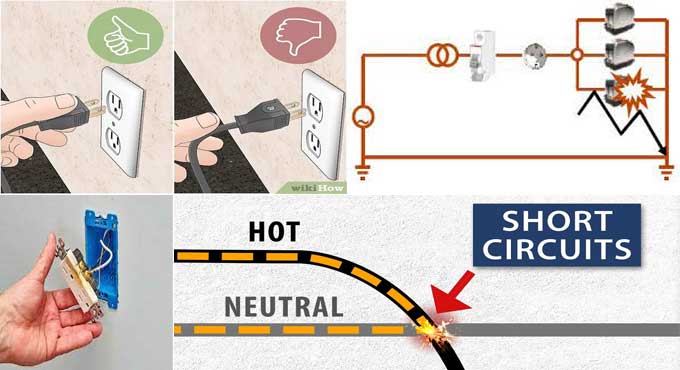
A brief explanation of short circuits, their causes, and methods of prevention

What do you mean by short circuit?
When there is a low-resistance connection between two conductors that deliver electricity to a circuit, a short circuit happens. This would cause an excessive current flow and an excessive voltage streaming in the power supply. A short circuit results from the electricity moving along a short path.
A home's electrical service panel is the starting point of an electrical circuit, which is a continuous flow of electricity. This flow is constant and uninterrupted. Outlets and lights are examples of circuit-related items that just borrow from the circuit; they do not cause a circuit break.
It is natural for electricity to go in the direction of the least resistance. Because metal transmits electricity so effectively, copper is utilised for electrical cables, whereas fibre or wood would be incredibly wasteful because they do not. Although they are superior to wood or fibre, even steel and iron are terrible materials for wiring.
Varieties of Short Circuit
Generally, short circuits are of two types. They are:
Ground Fault Short Circuit
When a live wire carrying current contacts a grounded section of the system, a ground fault short circuit occurs. The grounding of a metal wall box, the grounding of bare wires, and the grounding of an appliance can all be considered as examples.
Normal Short Circuit
Short circuits normally occur when hot wires carry current strike neutral wires. A significant amount of current will flow in a different direction as a result, resulting in a decrease in resistance.
What are the signs of an electric short circuit?
The outlet is making buzzing and popping noises
An outlet that makes a buzzing or popping sound is another warning sign. There is also the possibility that an overloaded circuit is causing this problem.
There might be sparks emitting from the circuit
The outlet may also spark if there is an electrical short circuit. Whenever there is a spark, it indicates that a high amount of current is flowing across the circuit, which can be dangerous.
Burn marks or a Burning smell might come out of electrical outlets
Whenever there are burn marks or an odour of burning coming from the outlet, this could be a sign of a short circuit. In most cases, this is the result of an overloaded circuit, which can cause a fire to occur.
A guide to preventing electrical short circuits
1. Due to the quantity of power, they carry, lightning strikes might result in harmful short circuits. To avoid power surges and short circuits, one should not use electricity during a storm.
2. Faulty wiring or cracks in an appliance can also lead to a short circuit. It is imperative that the faulty equipment is repaired or replaced as soon as possible.
3. Keep an eye out for any signs of broken outlets. If the outlet is more than 10 to 20 years old, the wires may be broken, the box connections may be loose, or a short circuit may occur.
4. There should be an avoidance of using multiple sockets at the same time or overloading any one plug since doing so might lead to a fire or a short circuit if you overdo it.
5. As an additional measure to prevent an electrical short circuit from occurring, a few devices can also be installed, such as:
RCD or RCCB - There is a type of safety device known as a residual current circuit breaker (RCCB) which detects if there is a problem with the home's electrical supply and shuts it down in 10 to 15 milliseconds. This prevents electric shocks from occurring.
Ground-Fault Circuit Interrupters or GFCIs - Electrical flow is compared using GFCI technology to determine whether a circuit is faulty. In the event of a ground fault or an imbalance in currents, the GFCI will cut off the electricity.
Arc-Fault Circuit Interrupters or AFCIs - Upon being triggered by an arc, an AFCI shuts off the power to a circuit in the event an arc is detected. The reduction of electrical fires can be achieved by doing so.
Inrush Current Limiter - There are several types of inrush current limiters, most of which are designed to prevent damage to electrical equipment and the blowing of fuses.
To learn more, watch the following video tutorial.
Video Source: AMRE Supply
Circuit breaker - The circuit breaker prevents abnormal current flow in a circuit by switching equipment. Using an internal spring or compressed air system, it detects changes in current flow. The current flow will be stopped as the circuit is broken open.
Fuse - The purpose of fuses is to protect electrical equipment from damage caused by excessive current flows. There is a strip or wire of metal that consists of a short circuit breaker that melts when a high current travels across it, breaking the circuit.
Poly Switch - Electronic circuits are protected from overcurrent problems by resettable fuses, also known as poly fuses, multi-fuses, and poly switches.
Lightning Protector - You can use a lightning protector which is generally made up of metal oxide varistor (MOV). The function of this lighting protector is to act as a discharge tube which discharges excess current.


